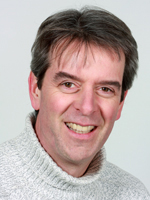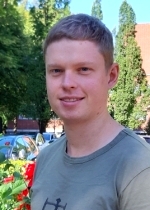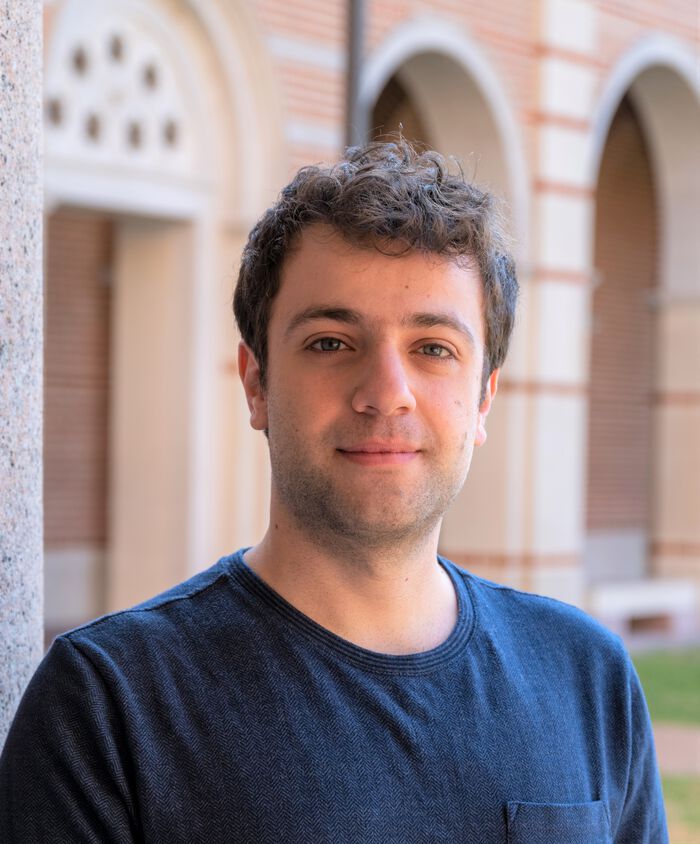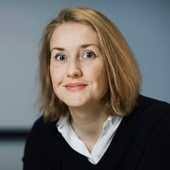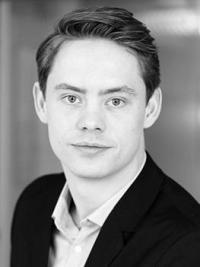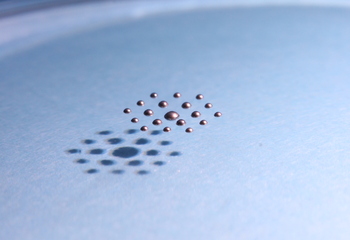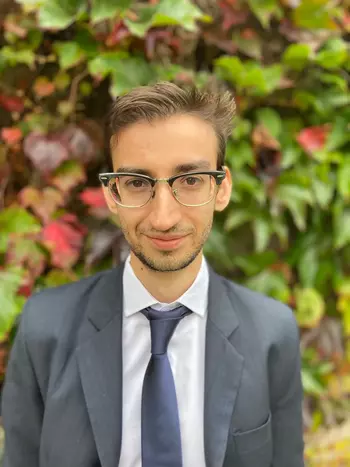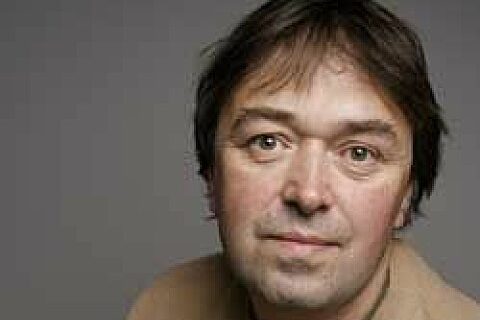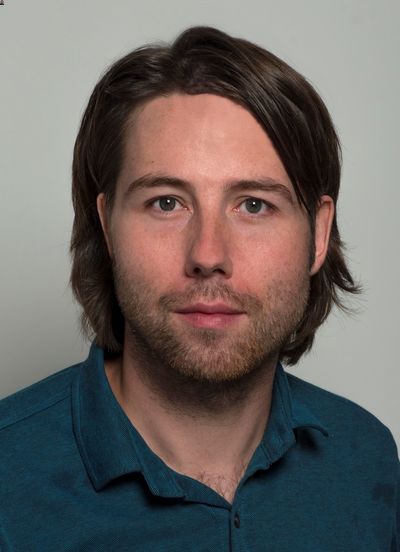Events
Previous
We consider several situations where drops can be captured by fibrous materials, from sprays on textiles (where the droplets are much larger than the typical fiber size) to meshes placed in a flow of fog (where the droplets are smaller than the typical fiber size). This last system, often encountered in aerosol filtration, exhibits a wealth of phenomena coupling capillarity and aerodynamics. In particular, we characterize experimentally and theoretically the deposition of the mist droplets on the fibre and the flow through and around the porous mesh, that both strongly depend on the mesh porosity and fine structure (i.e. the arrangements of the fibers). We further consider the dynamics of large drops sitting on fibers when exposed to a cross-flow, in particular their interactions with their unsteady wakes.
A liquid droplet placed on a rigid, planar surface has a captivating simplicity: its surface is a spherical cap and remains in equilibrium. In this talk, I’ll show that the addition of a deformable boundary leads to a range of new phenomena: evaporating droplets with an elastic skin may develop flat tops, but even without a complex rheology, reaching equilibrium can happen slowly, with the droplet’s contact ageing. I will discuss two specific examples, presenting a combination of theory and experiment for each.
The theory of flexible plates can be applied to models of floating solar panels. When wet, the structure vibrates with lower frequencies than when in vacuo. Our study is concerned with thin rectangular porous plates with free edge conditions in three dimensions exposed to incoming waves. We develop a complete hydrodynamical theory of the wave-flexible-structure interaction including the coupled radiation-diffraction problem. The formulation leads to a set of integral equations for the potentials on the wetted side of the plate. The Green function in three dimensions is implemented along the floating geometry. We use the beam method for the displacement of the rectangular free plate. A variational equation is minimized for the solutions of the interaction problem
The frictional behavior of surfaces is a problem of great scientific and practical significance. Recent progress in molecular scale modeling allows us to determine the coefficient of friction for nanoscale surfaces from first principles using molecular dynamics modeling. However, inverse design, that is, designing surfaces with specific frictional propeties is still a complex and largely unsolved challenge in part due to the enormous space of possible surface configurations. Here, we demonstrate how we can use physical forward modeling to find the frictional properties of a set of surfaces that can serve as a training set to design machine learning models. In this talk, we demonstrate both discriminative and generative models for frictional surface design and analyze what physical principles the machine learning models have learned in this process.
During this cold winter in Oslo, we certainly all have experienced the unsteady nature of friction and the sudden loss of stress bearing capacity that initiates catastrophic sliding. A similar kind of frictional rupture arises at the onset of a wide variety of natural disasters that includes earthquakes, landslides, as well as snow avalanches. In this talk, I will focus on the incipient stage of these catastrophic events that is characterized by the local nucleation of failure and its rapid propagation towards intact regions of the material. I will discuss how the analogy to fracture mechanics can be exploited to describe the dynamics of these rupture fronts and develop quantitative models to characterize the onset of failure in geomaterials.
Bone stress injuries affect athletic populations who undertake activities in which bones are repeatedly loaded. In order to understand and reduce the risk of bone stress injuries, we need to quantify the loading experienced by the bones during activities such as running. Bone loading is difficult to quantify as the magnitudes of stress are influenced to a large extent by the magnitude of muscular forces acting on the bone. Musculoskeletal modelling, ranging from very simple to very complex approaches, can be used to estimate the internal loading experienced by the bone during running. This has allowed us to explore factors such as speed, slope and step length and their influence on bone loading during running. However, in order to truly understand risk of stress injuries this needs to be taken out of the lab and in-field. This talk will consider what we know and the limitations to current understanding.
Future robots need to be robust and adaptable, and new design approaches are needed for new production methods. I will talk about my research in using evolutionary algorithms and biologically inspired methods with the aim of having more intelligent, robust, and adaptive behavior in robots. I will give a short introduction to some of the algorithms and show how we apply them in our robotic platforms for exploring automatic design and adaptation.
Engineering principles to develop advanced biomaterials and scaffolds. This study focuses on utilising engineering principles to facilitate new bone growth, specifically in designing and fabricating bone scaffolds. The core of our investigation lies in applying titanium dioxide (TiO2) scaffolds, which have emerged as promising candidates due to their osteoconductive properties and the potential for enhancing bone tissue engineering.
Our research aims to bridge the gap between engineering and biology by harnessing fluid mechanics and material science to create scaffolds that mimic the natural bone environment. By comparing TiO2 scaffolds with commercial porous calcium phosphate biomaterials under simulated perfusion culture conditions, we delve into the mechanical and fluidic stimuli that are crucial for bone regeneration. The study emphasises the role of fluid dynamics to make better “spare-parts” for the human body, highlighting the importance of permeability, mechanical load transfer and wall shear stress with a porous ceramic.
Furthermore, we validate our fluid mechanic simulations with the impact of dynamic seeding techniques. Our findings demonstrate the superiority of dynamic culture conditions in enhancing the expression of bone-related proteins and genes, thereby facilitating more effective bone regeneration. In addition, the study presents a clinical trial that shows that these porous bioceramic functions well in patients. The trial's outcomes confirm the potential of TiO2 scaffolds for in vivo bone formation and showcase the successful integration of engineering principles in the development of biomaterials for tissue engineering.
This research underscores the pivotal role of engineering in advancing tissue engineering and biomaterials science. By leveraging engineering principles to optimise scaffold design and functionality, we pave the way for innovative strategies in bone regeneration, offering new hope for patients requiring bone tissue reconstruction.
Paper cuts are a minor nuisance, but they can lead to life-threatening microbial infections. The physical processes that determine whether paper cuts into the skin, however, remain poorly understood. To explore skin-paper interactions, we designed an experiment in which a piece of paper contacts an artificial finger made from ballistic gelatin. Our experiments suggest that the paper thickness is one of the most important parameters in determining cutting efficacy. A relatively thin sheet often buckles before cutting is initiated, whereas the predominant interaction with thick sheets is indentation. Our preliminary data indicate that a successful paper cut is physically impossible outside a relatively narrow range of thicknesses for a given angle. Finally, the optimal paper cut is explored, and the influence of skin properties and cutting angle is discussed.
Controlling the spontaneous ruptures of nanoscale liquid thin films is crucial to various applications such as solar cell manufacturing. Over the past few decades, theoretical work based on the long-wave theory of thin liquid films has successfully identified a critical film height, below which the surface nanowaves become linearly unstable, leading to spontaneous rupture. This dewetting in the ‘spinodal regime’ has been repeatedly confirmed in experiments using atomic force microscopy on polymer films. However, ruptures are also observed for thicker films (linearly stable) in a different manner. It is believed that the random (Brownian) movement of particles is the cause of dewetting in this ‘thermal regime’ but the theoretical framework predicting the rupture is missing. In this talk, we present a theory to account for the rupture of a two dimensional linearly stable thin film by utilizing fluctuating hydrodynamics and rare events theory. By modelling the film dynamics with the stochastic thin-film equation (STF) and solving it numerically, we observe rupture in the linearly stable thermal regime and record the average waiting time for rupture. We show that the STF can be rearranged into the form of a gradient flow, which allows us to apply Kramer’s law from the rare events theory to obtain a theoretical prediction of the average waiting time. Molecular dynamics (MD) simulations are also performed and we find good agreements between the numerics, the prediction, and the MD.
Protein condensates inside human cells are liquid-like droplets composed of protein and RNA. These condensates interact with the heterogeneous, active and dense environment of the cytoplasm, crossed by various cytoskeletal filaments such as microtubules and actin. Wetting interactions with the cytoskeleton lead to stereotypical positioning of such protein droplets inside the cell. Using statistical physics approaches, we identified complementary functions of filamentous actin and microtubules: protein droplets couple to actin’s native dynamics in the cell through steric interactions leading to directional motion towards the cell center. Microtubules (and their molecular building-blocks), on the other hand, act as Pickering agents and engage in energetically favorable wetting interactions that lead to a robust localization of protein condensates in microtubule-rich regions of the cell. These interactions are non-specific and ultimately arise from different affinities (contact angles) between condensate and filament, suggesting that similar mechanisms may govern localization of other liquid-like phases within the cell.
What happens if we paint a steel box and put a water drop on it before it gets dry? The arcane curiosity arises: Will the paint remain the same or get destroyed? The answer is that it depends on the interaction between the surfaces and the length scale involved. My doctoral work was to study the stability of thin liquid films under aqueous drops. Slippery surfaces were used as a model system because they provide a frictionless surface with low contact angle hysteresis (<2°). We found that thin liquid films are stable on hydrophobic surfaces, while on hydrophilic surfaces, they rupture and dewet into droplets. We observed different dewetting patterns depending on the film thickness and slip. However, films on hydrophobic surfaces are stable but can be destabilized using external perturbations like an electric field. Due to the electric field, capillary waves are generated, and their evolution matches very well with a linear stability analysis. The reversible dewetting behavior with the applied field is an interesting observation of our work. With the applied frequency, the wavelength of the capillary waves does not follow the classical linear stability analysis; we modified the stability analysis, which agrees with our experimental findings. Finally, the coalescence of dewetted droplets and anomalous diffusive behavior with the applied external field will be discussed
Physics of internal microstructure fluid flows plays important role both due to their applications as well as their more general research field. In most occasions this type of fluid flow problems are treated with discrete models that are both computational costly as well as unable to shed light into the more general physics of the problem. In this sense a continuous model in the Eulerian frame is adopted here that consists a generalization of the incompressible Navier-Stokes equation. The present model introduces an extra tensor in the governing equations that accounts for the angular velocity of the internal microstructure, namely the micropolar model.
A peculiarity of nonlinear hyperbolic problems is that they must be interpreted as limits of second-order equations with vanishing viscosity. Despite not explicitly being present in the hyperbolic case, diffusion is needed, e. g., at discontinuities or to avoid the occurrence of nonphysical states. In the case of gas dynamics, for instance, dissipation corresponds to the production of thermodynamic entropy. To solve hyperbolic problems numerically, one needs to adapt these ideas to the discrete setting. Standard high-order methods, however, do not incorporate the appropriate amounts of artificial viscosity because these need to be chosen adaptively based on the solution. Among the high-resolution schemes capable of doing so are the recently proposed monolithic convex limiting (MCL) techniques [1] to be discussed in this talk. They offer a way to enforce physical admissibility, entropy stability, and discrete maximum principles for conservation laws. These methods can also be generalized to systems of balance laws in a well-balanced manner [2]. In addition to second-order finite element methods, extensions to high-order discontinuous Galerkin (DG) schemes shall also be presented [3]. Numerical examples for the so-called KPP problem, the nonconservative shallow water system, and the compressible Euler equations will be shown. An overview of MCL and other property-preserving methods can be found in our recently published book [4].
We combine a pressure correction scheme with interior penalty discontinuous Galerkin (dG) discretisation to solve the time-dependent Navier–Stokes equations. We prove unconditional energy stability and a priori error estimates for the velocity. With duality arguments, optimal L2 error rates are obtained. Convergence of the discrete pressure is also established. Further, we propose a splitting scheme, integrating the pressure correction approach, for the Cahn–Hilliard–Navier–Stokes system The numerical analysis of dG combined with this scheme is discussed. Namely, we show well--posedness, stability, and error estimates. Numerical results with manufactured solutions display our theoretical findings, and a spinodal decomposition example portrays the robustness of our approach.
Your brain has its own waterscape: whether you are reading, thinking or sleeping, fluid flows through or around the brain tissue, clearing waste in the process. These biophysical processes are crucial for the well-being and function of the brain. In spite of their importance we understand them but little, and mathematical and computational modelling could play a crucial role in gaining new insight. In this talk, I will give an overview of mathematical, mechanical and numerical approaches to understand mechanisms underlying pulsatility, fluid flow and solute transport in the human brain. Topics include fluid-structure interactions, generalized poroelasticity, mixed finite element discretizations and preconditioning, uncertainty quantification, and optimal control.
30-31 October 2023, Oslo, Norway.
The symposium is a follow-up of six highly successful previous DNVA-RSE Norway-Scotland Symposia. Topics of this year's symposium include: Water Waves and Internal Waves, and the widened scope to include the following multi- and inter-disciplinary marine topics: Hydrodynamic processes in the coastal ocean and fjords, Microbial processes, Robotics for observations in the ocean, Corals and plankton, and Arctic-related problems.
Fluid efflux from the brain plays an important role in solute waste clearance. Current experimental approaches provide little spatial information or data collection is limited due to short duration or low frequency of sampling. One approach shows tracer efflux to be independent of molecular size, indicating bulk flow, yet also decelerating like simple membrane diffusion. In an apparent contradiction to this report, other studies point to tracer efflux acceleration following infusions. In this talk, I will share a stylized advection-diffusion model for clearance of waste, which reconciles the apparent contradiction, and discuss methods to validate it with novel MRI data. Being stylized, it is also simple enough to permit a dimensional analysis which indicates that clearance of waste from the brain is governed by three dimensionless quantities including a potential bottle-neck for clearance due to transport across the surface membranes.
Cavitation is a ubiquitous and sometimes destructive, phenomenon. For instance, cavitation bubbles may interrupt water flow in plants or severely damage the surfaces of machines such as pumps and propellers. The so-called tribonucleation of vapor bubbles has been proposed to be responsible for the cracking sound produced by the manipulation of human synovial joints. To study cavitation up close we have developed an experimental setup where a sphere in water abruptly leaves a flat surface starting from a separation of only 10 nm.
Upon upward movement of the spherical surface, a cavitation bubble forms and develops branched fingers through the Saffmann-Taylor instability. Simultaneously, negative liquid pressures in the range of ∼10atm are observed. These large tension values occasionally lead to secondary nucleation events. The bubble sizes satisfy a predicted Familiy-Vicsek scaling law where the bubble area is proportional to the inverse bubble lifetime. The fact that creeping flow cavitation bubbles are more short lived the larger they are separate them from bubbles that are governed by inertial dynamics.
Self-assembly is the spontaneous generation of order in systems driven by thermal agitation and interactions. At the molecular level, self-assembly plays an important role in the formation of giant com- plex macromolecules, being quite relevant for living systems. At the mesoscopic level, capillary driven self-assembly has been proposed for building structures in the gap between classical bottom-up and top-down fabrication methods, i.e. at the scales in between 10 micrometers and 1 millimeter. Although the method was proposed 20 years ago, only regular or simple structures were achieved so far. Using both experimental and statistical physics ideas, we demonstrate how to exploit subtle capillary interactions to create elaborate complex structures, as well as functional micromachines. On top of that, we show how such mescoscopic systems can be the analogues of many different physical systems such as folding molecules, molecular locks and keys, and crystal formation.
Active solids consume energy to allow for actuation and shape change not possible in equilibrium. In this talk, I will focus on the elasticity of systems as wide-ranging as far-from-equilibrium hydrogels, nanoparticles, and mechanical structures composed of active robotic components. First, I will introduce our recent work on hydrogel spheres being lowered onto a hot plate. As the bottom vaporises, the resulting flow couples tightly to elastic deformations within the sphere, giving either spontaneous bouncing or steady-state floating as manifestations of the so-called elastic Leidenfrost effect. I will present theory and simulations of the floating case, which demonstrate a remarkable phenomenon: the heavier the solid, the higher it floats. I will then discuss the general competition between active boundary stresses and an elastic bulk, giving rise to so-called active elastocapillarity. Finally, I will discuss our current work on using non-reciprocal interactions in active elastic media to program robust mechanical actuation and locomotion. In each case, our results provide theoretical underpinning for recent experimental advances, and point to the design of novel soft machines.
Innovations in fluid mechanics are leading to better food since ancient history, while creativity in cooking inspires applied and fundamental science. In this talk, I will discuss how recent advances in hydrodynamics are changing food science, and how the surprising phenomena that arise in the kitchen lead to discoveries and technologies across the disciplines, including rheology and soft matter. Central topics include cocktails and champagne (multiphase flows), whipped cream (complex fluids) and pancake making (viscous flows). For every topic, I will present the state-of-the-art knowledge, the open problems, and likely directions for future research.
Publications:
Mathijssen, A. J., Lisicki, M., Prakash, V. N., & Mossige, E. J. (2023). Culinary fluid mechanics and other currents in food science. Reviews of Modern Physics, 95(2), 025004.
Fuller, G. G., Lisicki, M., Mathijssen, A. J., Mossige, E. J., Pasquino, R., Prakash, V. N., & Ramos, L. (2022). Kitchen flows: Making science more accessible, affordable, and curiosity driven. Physics of Fluids, 34(11).
We have developed a pump-less recirculation Organ-on-Chip (rOoC) platform that generates a directional gravity-driven flow. This platform can be adapted to various flow conditions and enables the study of endothelial lining, blood vessel sprouting, circulation of immune cells, pathogens or other particles, and incorporation of 3D cell models like organoids. Additionally, we have developed a computational model to predict shear stress and mass transport within the rOoC, allowing for customization of the platform for various use-cases.
The rOoC platform is very versatile and can be used to model for instance drug-induced liver-injury (DILI) that mimics the complex interaction between resident human stem cell-derived liver organoids (3D-HLO) and circulating immune cells. Moreover, we show the functional crosstalk between 3D-HLOs and human pancreatic islets to model the onset of type-2 diabetes.
